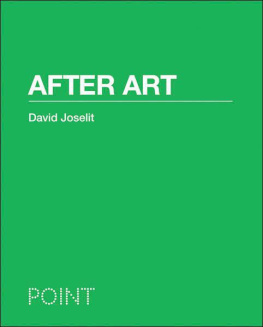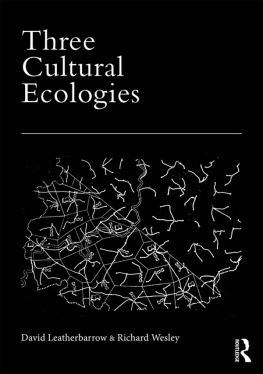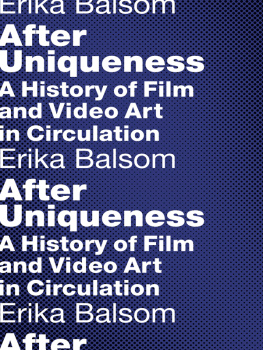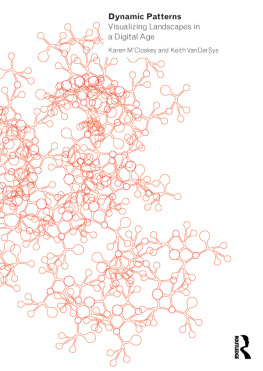After Art
POINT
SERIES EDITOR | Sarah Whiting |
Kissing Architecture by Sylvia Lavin |
After Art
David Joselit
Princeton University Press Princeton and Oxford
Copyright 2013 by Princeton University Press
Published by Princeton University Press, 41
William Street, Princeton, New Jersey 08540
In the United Kingdom: Princeton University Press, 6
Oxford Street, Woodstock, Oxfordshire OX20 1TW
press.princeton.edu
All Rights Reserved
Library of Congress Cataloging-in-Publication Data
Joselit, David.
After art / David Joselit.
pages cm (Point)
Includes bibliographical references and index.
ISBN 978-0-691-15044-4 (hardcover : alk. paper) 1. ArtPsychology. 2. Art and society. I. Title.
N71.J68 2012
701dc23
British Library Cataloging-in-Publication Data is available
Publication of this book has been aided by the History of Art Department, Yale University.
This book has been composed in Helvetica and Scala
Printed on acid-free paper.
Printed in China
10 9 8 7 6 5 4 3 2 1
In memory of Jill S. Joselit
Business art is the step that comes after Art
Andy Warhol
Contents
Acknowledgments
After Art is based on a series of three lectures, States of Form, that I gave as Kirk Varnedoe Professor at the Institute of Fine Arts during the spring of 2010. I am grateful to everyone at the IFA who hosted me so graciously, especially Director Patricia Rubin, whose characteristic intelligence and engagement with my ideas was extremely gratifying, and Professor Priscilla Soucek, who worked so hard to make my temporary appointment at NYU possible. Christina Snylyk managed the lecture series beautifully, and Jason Varone was a wizard with media. I thank Emily Bakemeier, Deputy Provost at Yale, for smoothing the administrative hurdles in accepting this position. I have benefited from the generosity of colleagues who have shared their expertise with me: Virginia Rutledge was extremely helpful in discussing issues of copyright and image commons, Roger Buergel helped clarify several aspects of Ai Weiweis work, Fairytale, Keller Easterling assisted me in understanding the repurposing of architecture, and Francesco Casetti, with whom I taught a course related to this book in the spring of 2011, was ever a stimulating interlocutor whose ideas have inspired me. I am also grateful to the two anonymous readers of my first draft whose comments I have benefited from enormously.
Geoff Kaplan worked assiduously and imaginatively to crystallize my ideas into eloquent diagrams for this book. Stephanie Romeo did an amazing job as photo researcher. I am grateful to the History of Art Department at Yale, and especially the Department Chair, Professor Alexander Nemerov, for underwriting the costs of image rights and reproductions as well as making available a generous subvention. POINT series editor Sarah Whiting has been a pleasure to work with and has improved this book enormously. I am grateful to Hanne Winarksy for encouraging me to pursue this project as After Art and to Princeton University Press editor-in-chief Brigitta van Rheinberg and editor Alison MacKeen for their support. Christopher Chung and Kelly Malloy have been most helpful. Since After Art is a sequel of sorts to my book Feedback: Television Against Democracy, I want thank Roger Conover at MIT Press for his backing of that project.
As always, I am grateful for the support of my partner, Steve Incontro, who is patient, loving, and intellectually challenging. This book is dedicated to the memory of my mother, Jill S. Joselit.
Preface

Diagram 1. Designed by Geoff Kaplan.
There are three dominant attitudes toward images that parallel those pillars of grade school educationreading, writing, and rithmeticwith three Ds: derivative, dumb, and deceptive.
Derivative: Images are thought to derive significance from external sources. Whether tethered to a historical era or a philosophical idea, they are treated as illustrationsas vessels for borrowed content.
The (widely shared) assumption of these authors is that visual intelligence is insufficiently disciplined to cross the threshold of formal (i.e., genuine) knowledge.
Deceptive: As sources of pleasure, images deceive. They create the ideological fantasias that Guy Debord so lustily condemned in his 1967 manifesto, The Society of the Spectacle, and that critics from both the right and the left have loved to hate ever since. As spectacle, images are the opposite of knowledgethey are the epitome of ignorance.
After Art will assert that images possess vast power through their capacity for replication, remediation, and dissemination at variable velocities. In order to exploit this power for progressive ends, it is necessary to understand the potency of images on their own terms rather than dismissing them as derivative, dumb, and deceptive. To this purpose, After Art will shift critical emphasis from arts production (and the corollary of artistic intention) to what images do once they enter circulation in heterogeneous networks. While Post leaves the art object in tact albeit transformed or negated, whereas after shifts emphasis to its effectsits powerunder the conditions of circulation.
The term image is a slippery one. I will use it here to indicate a quantum of visual content (say a digital photograph) that can assume a variety of formats. For instance, any digital photograph may remain a computer file, or be printed in a variety of ways on a variety of surfaces; it lends itself to editing with software like Photoshop, and it can be degraded in quality by emailing or uploading it. In short, an image is a visual byte, vulnerable to virtually infinite remediation. The icon that heads this preface, which appears in a sequence of diagrams punctuating After Art, was designed by Geoff Kaplan to signify a new, more productive understanding of the power of images. Here are three of its aspects:
Eye and I: the letter i in the center of the icon suggests both a pupil and a pronoun, just as images combine sensory and conceptual forms of information that, together, constitute their connection or link with spectators.
Scalability and transformation: Images are a form of information that may shift from two dimensions to three, from tiny to huge, or from one material substrate to another, just as the image-icon in this book will move through several formats or situations in its sequence of diagrams.
Power and currency: The icon approximates a plug where the i functions as a prong entering a disk. I will argue that images produce powera current or currencythat is activated by contact with spectators. The more points of contact an image is able to establish, the greater its power will be.
Image Explosion
The scale at which images proliferate and the speed with which they travel have never been greater.without a price). It is an instrument invented to transfer value easily and efficientlyand now, with the aid of computers, almost instantaneously. Even the negligible materiality of paper money has grown practically obsoleterequired only for a fraction of transactions. Currencies are universal translators: they can assign a value to every kind of commodity, whether goods or services. In the 1990s a second type of universal translator gained prominence: digital technologies with the capacity to transpose any work in sound, image, or text into numerical sequencesinto code. Contemporary art and architecture are produced at the intersection of these two universal translatorsone that specifies value, and the other that specifies form. But how can we describe the aesthetics of a currency like art?









